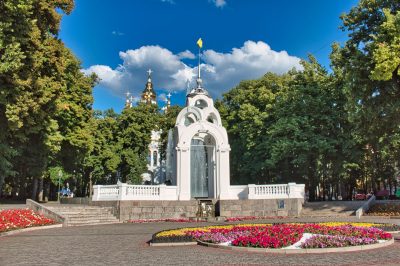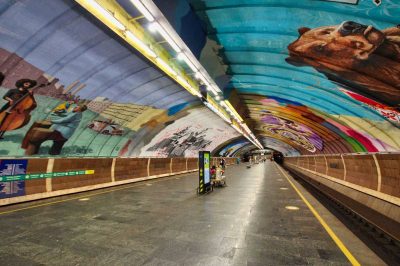The wind whistles coldly across Independence Square. And it has plenty of room for that, because it one of the largest squares in Europe. But I’m not here to freeze. Because the square, itself quite empty, gathers some of the best examples of Soviet architecture from different decades around it. And not only here but in the whole city you can still find the remains of the Soviet Union. Soviet Kharkiv – this is a tour of this microcosm of Soviet architecture and the history of the Soviet Union through one city. After all, Kharkiv has experienced almost all phases of the Soviet era and this is reflected in the cityscape.
Ukrainian Spring in the Capital of Soviet Ukraine
After the Soviets won the civil war against the “Whites,” a consolidation took place in the twenties. Joseph Stalin did not yet have the all-encompassing power with which he later deported and murdered entire peoples. While the western part of the country was occupied by Poland and belonged to the Polish Second Republic, Kyiv and Kharkiv were part of the Ukrainian Soviet Socialist Republic.
Kharkiv, not Kyiv, was the capital of this Soviet republic. In order to better integrate Ukraine into the Soviet Union, the Soviets initially allowed a diverse use of the Ukrainian language, of which Ukrainians in other countries were sometimes even envious. More than 80 percent of Kharkiv’s citizens and even more people in the surrounding areas spoke Ukrainian at that time.
Soviet Constructivism – The revolution changes the architecture too
The 1920s were a heyday of progressive thinking and there was experimentation with freedoms for Ukrainian art, language and culture. And experimentation was desired in architecture as well. The best designers of the Soviet Union tried new forms in architecture and industrial design. It was the avant-garde of the red empire and showed what achievements the new state could be capable of. Many of the ideas were taken up again in the architecture of the later Soviet years. The parallels to the Bauhaus in Germany are also astounding, which was also due to some of the contacts of the designers involved.
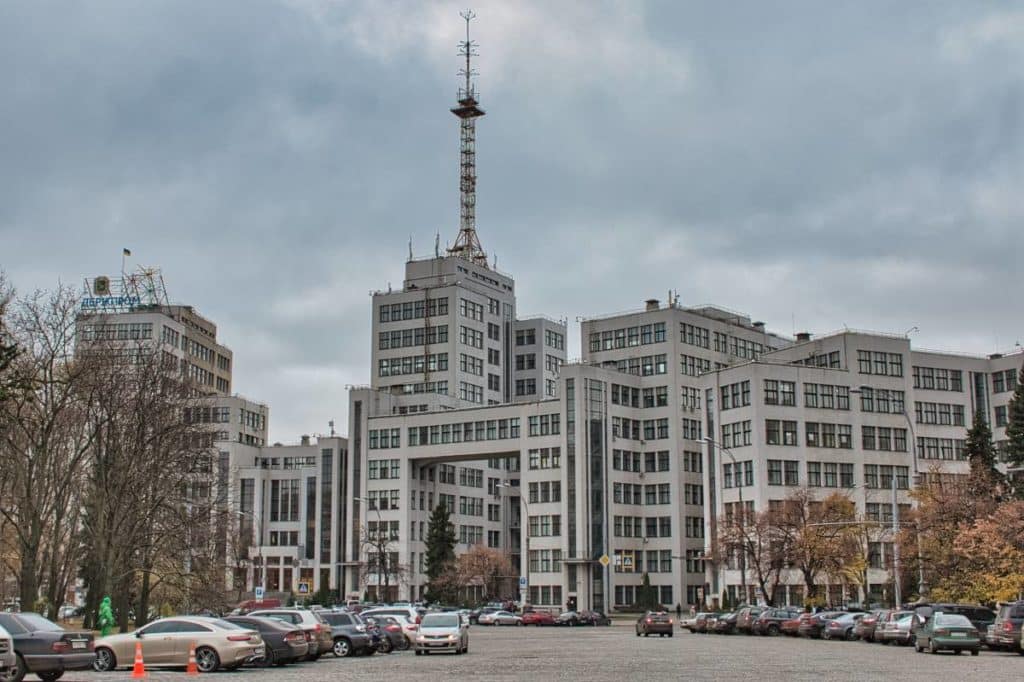




Dershprom – Crown Jewel of Constructivism in Kharkiv
Built between 1925 and 1928, the Dershprom building in particular attracts attention. This is because the building is something like the archetype of a Soviet skyscraper. The 63-meter-high building (108 meters with television antenna) was the first of its kind in the entire Soviet Union. It is built in the style of Soviet constructivism. I like these buildings because they are much more sober than the ostentatious buildings of Stalin’s Baroque. And it is real quality work. Seven of the 12 elevators in the building still work today without being replaced. And that after almost 100 years!
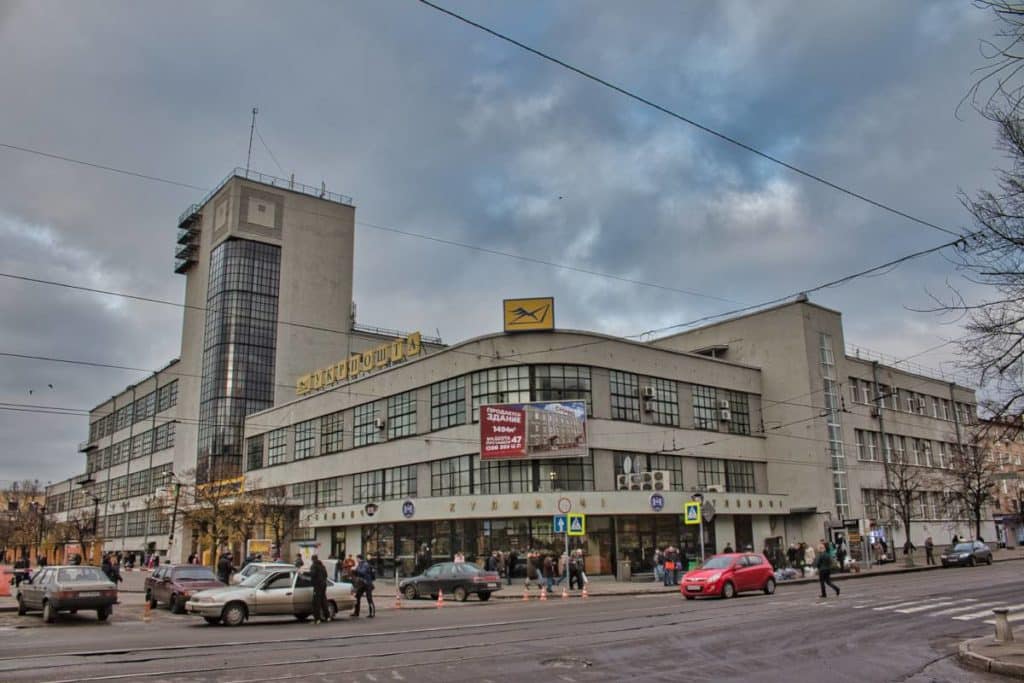

Kharkiv Main Post Office – Bauhaus called and wants its post office back
Exactly this had already reminded me of another building when I arrived in Kharkiv. Directly upon leaving the neoclassical train station, one sees the main post office, whose sober style reminds me very much of the Bauhaus building in Dessau. The elongated shape and the slender tower with the steel enclosures look very similar to the icon of modernism in Dessau. Sober, useful and beautiful to many eyes. The post office was also badly destroyed during the Second World War. But at least it was rebuilt and not replaced by a Stalinist block like the train station next door.






Taras Shevchenko Monument – Sign of a Ukrainian spring
Also, long before the war, a monument was erected in honor of Taras Shevchenko. In 1934 sculptors from Ukraine created the work of art in honor of the most famous Ukrainian poet. Shevchenko was respected even by the communists, because he stood up against the injustice of serfdom. The monument was made in Leningrad at that time, as a plaque on the side of the monument reveals. Ironically enough today the Shevchenko monuments replace the Lenin statues in many Ukrainian cities.


Karazin University Kharkiv – Almost Brutalism
The Karazin University building was built between 1930 and 1932 and at that time already housed the university buildings. At 66 meters, its construction replaced the Derschprom as the tallest building in Ukraine. Originally, it was to house the Soviet People’s Commissariat for Ukraine. However, in the early 1930s Kyiv again became the capital of the Ukrainian SSR and the authorities decided to house the university here instead.
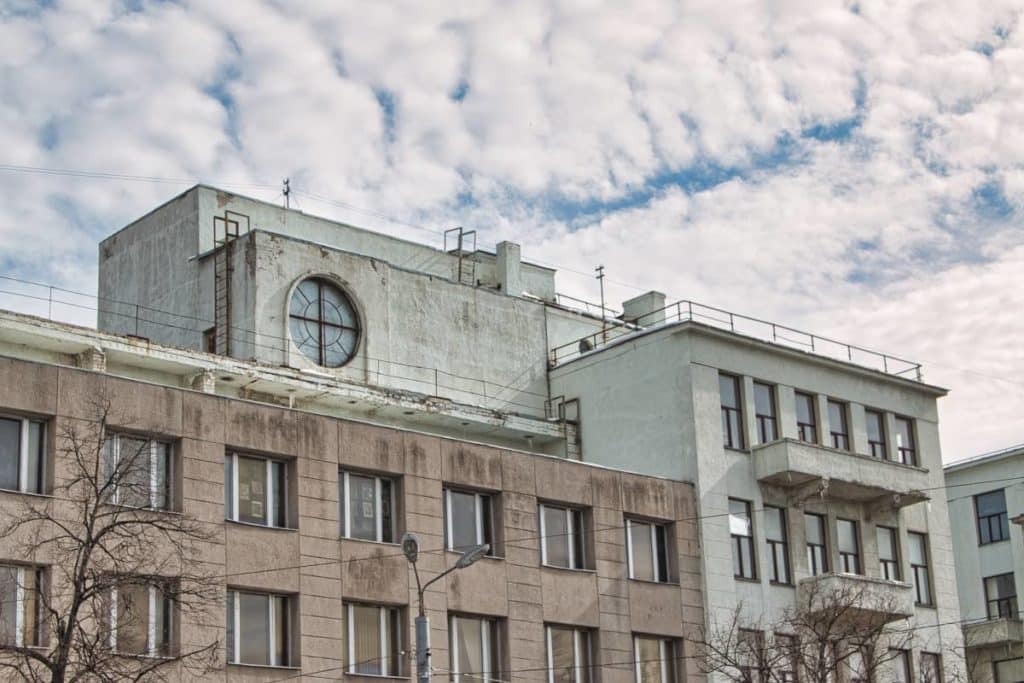
Kharkiv University of Architecture
The building of the University of Architecture also dates from this high period of architecture. It was built in 1927 and is also an example of constructivism in the city. To this day, the future architects of the region learn their craft here.

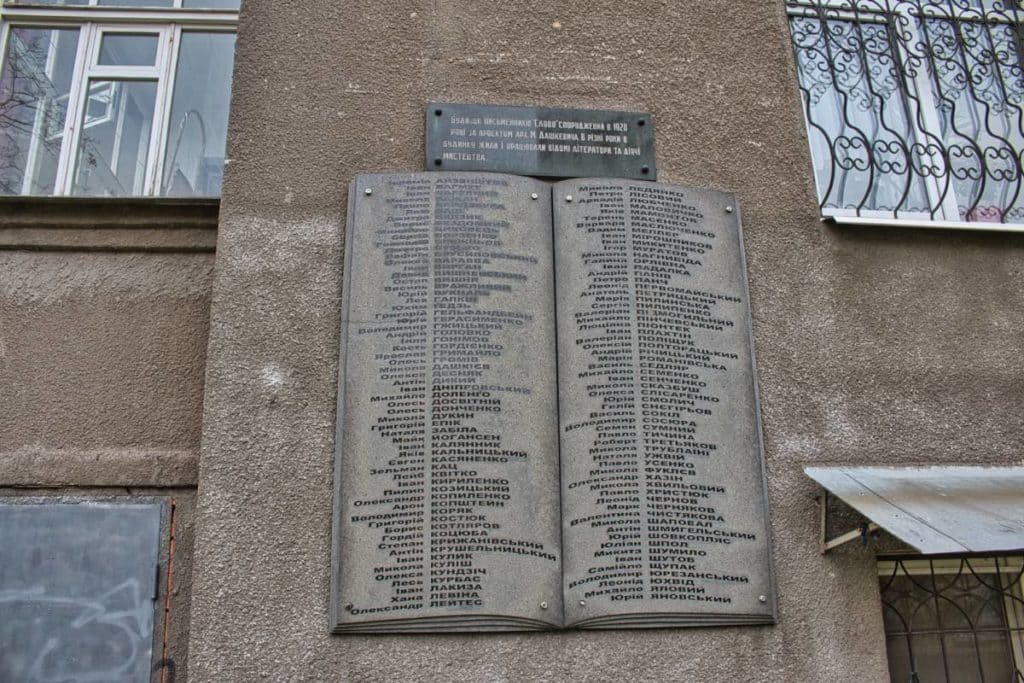
Slovo House and Les Kurbas – End of a dream
Kharkiv became a center of Ukrainian avant-garde literature and theater from the mid-twenties. That is why the Slowo House was built here in the late 1920s. It was a building of the Association of Artists of the city, where poets, writers and other artists could live cheaply, exchange ideas and develop joint projects.
But with the increasing repressions under Stalin, the house turned more and more from a center of free spirit to a prison in the Überwachungsstatt. More than 70 residents of the 60 apartments became victims of Stalin’s purges. This is commemorated today by a memorial plaque on the facade of the house. A project of young Kharkiv citizens is trying to come to terms with the history of the Slowo House in Kharkiv.
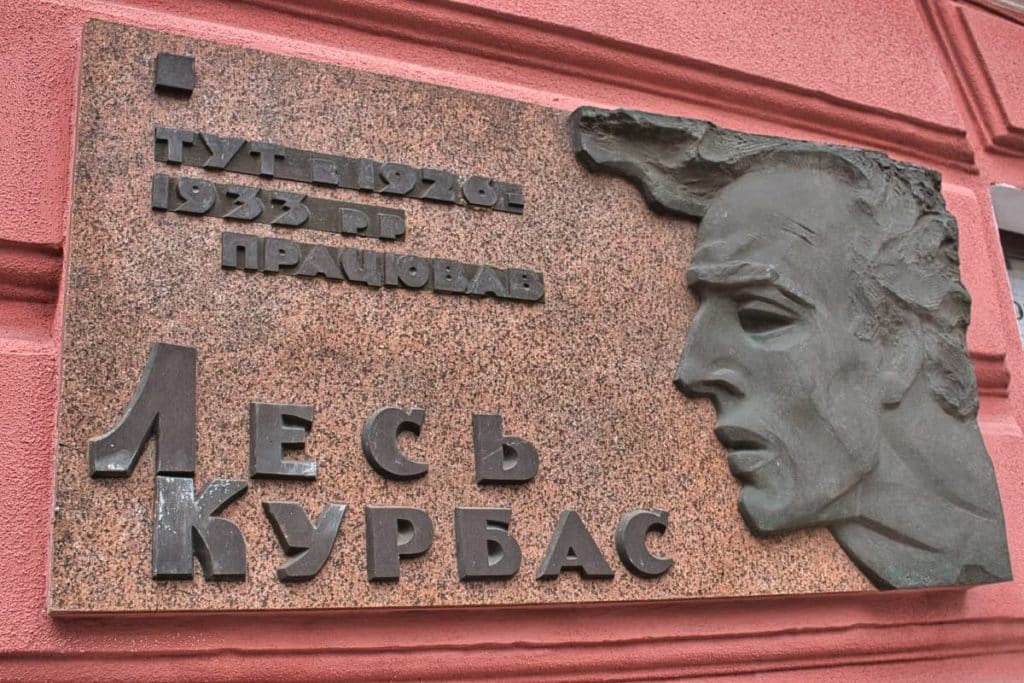
Les Kurbas, probably Ukraine’s best-known theater director, was also a victim of Stalin’s cleansings, having built up the famous avant-garde Beresil Theater in Kharkiv in the late 1920s. Kurbas, for example, combined expressionist techniques with Ukrainian traditions to create plays. He is also commemorated in the city today.
Stalinist Realism and Neoclassicism replace Constructivism
Little known in Germany, it was not until Stalin began to suppress the Ukrainian language and deliberately exterminate Ukrainians with a famine (Ukrainian: Holodomor). This forced Russification still characterizes the region today. It is also the origin of the conflict in eastern Ukraine. With the artists of constructivism, the architecture in Kharkiv was also replaced. In the Dzerzhprom building there is a small museum on the history of the administration of the city of Kharkiv through the decades. There I am kindly greeted by the museum employee.
She also shows me a book from the picture archive of the Prussian Cultural Heritage Archive, which shows photos of German war photographers of the Wehrmacht and of airplanes of the reconnaissance. With German thoroughness, the Nazis photographed the whole city in 1942 after its occupation by Nazi troops. On it you can see today’s Independence Square. The Dershprom and the surrounding buildings almost formed a circle at that time. The Nazi destruction of the city during the invasion of the Soviet Union left only the skeletons of many buildings. The Dershprom itself remained intact after the war. However, Stalinism demolished much of Kharkiv that had been painstakingly built before.

Communist Party Central Committee Building – Risen from Ruins
Originally, on the site of the Kharkiv Oblast Administration building stood a building from the Constructivist period. This was originally supposed to be the seat of the Communist Party of the Ukrainian Soviet Republic. With the transfer of the capital to Kyiv, the building became the seat of the Central Committee of the Communist Party in Kharkiv oblast. The architect was Jakov Steinberg, a Jew who fell victim to Stalin’s purges a few years later. During the Second World War, however, the originally very interesting building was largely destroyed. Then, in 1954, the building was replaced by a six-story structure in the style of neoclassicism. Until the collapse of the Soviet Union, the building was emblazoned with the coat of arms of the Soviet Union. In the meantime, it has been replaced by the coat of arms of Ukraine with the trident.










Kharkivskyi Traktornyi Zavod – Tractors for the Eastern Bloc
As early as the 1930s, the Kharkiv tractor plant was built then still 15 kilometers (10 miles) from the city center and delivered the first tractor in 1931. During the war, the plant was evacuated to the Altai Mountains ahead of the approaching German troops and returned only after the war. Mainly caterpillars and other vehicles with tracks were built here. Many wheeled tractors were also built in the ChaTeZe and in many cases transported to other countries of the Eastern Bloc.
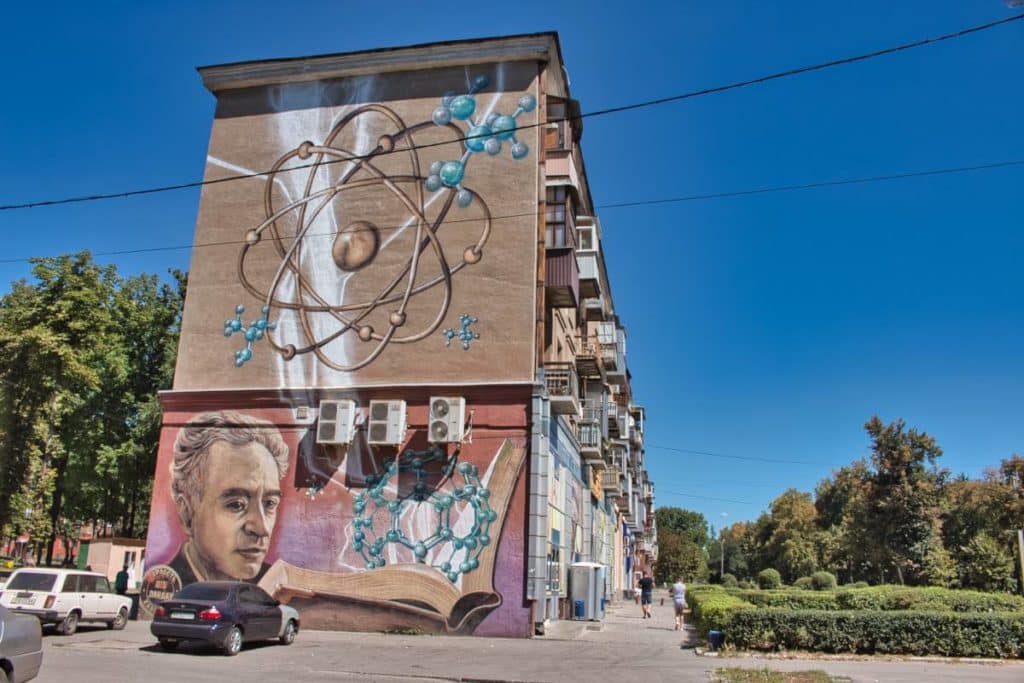
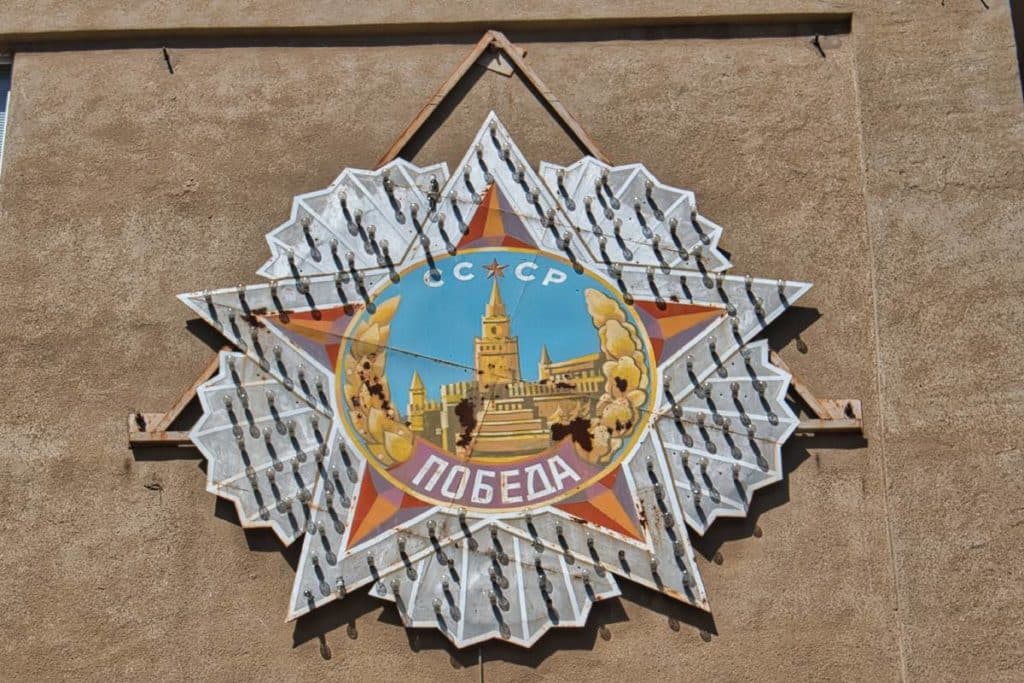
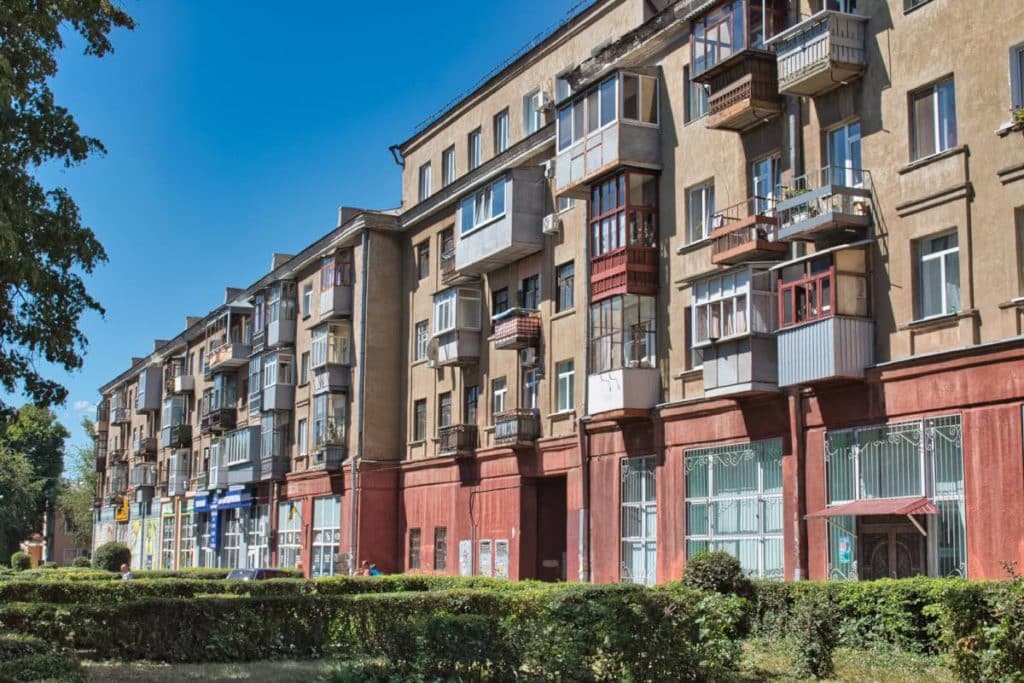
ChaTeZe – housing estate of the tractor factory
In the 1930s, a housing estate called Novy Kharkiv was built for the workers and their families at the tractor plant. At that time, these settlements were known as SozGorod – the socialist city – and were intended to show what the cities of the future would look like for the proletariat. The settlement was to contain everything that the workers and their families needed: Shopping facilities, kindergartens, schools and cultural houses. Even the traffic axes were already planned into the concept. For a long time, ChaTeZe had a reputation as a Gopnik neighborhood. In the meantime, however, the reputation has improved greatly, since apartments here are solid and the neighborhood is very green.



The train station and the giant samovar
Kharkiv Railway Station, with its neoclassical architecture, is one of the flagships of Stalinism in the city. Especially the ceiling paintings depicting the supposed victory of the working class should not be overlooked. In the station hall there is also a snack stand in the shape of a huge samovar. Samovars are the old tea kettles used to boil water on Ukrainian and other Soviet trains. Maybe it is even the biggest samovar ever built? The experts from the Guinness Book of Records should take a closer look at it!
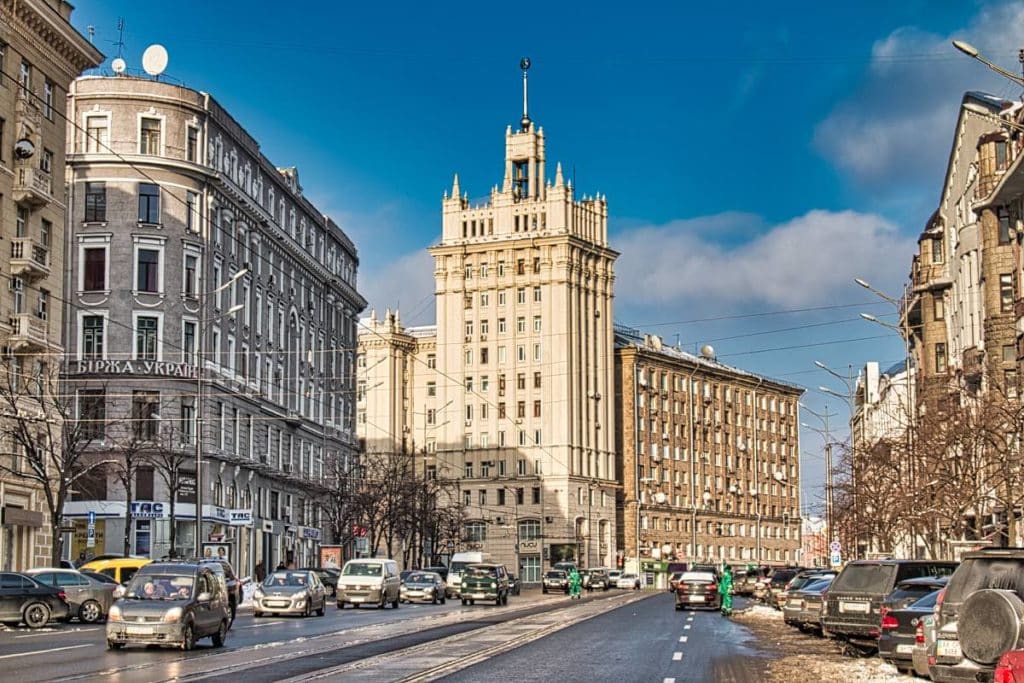
House with a Spire
The House with a Spire at the beginning of Sumska Street is another typical building from the Stalin era. It could also stand in Moscow or East Berlin. Especially the tower on which a big Soviet star used to be emblazoned is striking. It was built from 1950 to 1954 and was thus completed only after Stalin’s death. The tower has 12 floors. The building used to house the headquarters of an energy combine.
Soviet Modernism and Postmodernism – Thaw for Practical Ideas
After Stalin’s death, a thaw began in the Soviet Union. Old dogmas could finally be abolished and practical solutions again prevailed over ostentatious buildings. In Kharkiv, too, there were now new buildings of socialist modernism. In addition to the indispensable Krushchovkas, the residential buildings in prefabricated construction, there are some buildings to show off with. Later on, other approaches of Soviet architecture came to the fore, which today seem very brutalistic and were mainly created during the Soviet postmodernism.
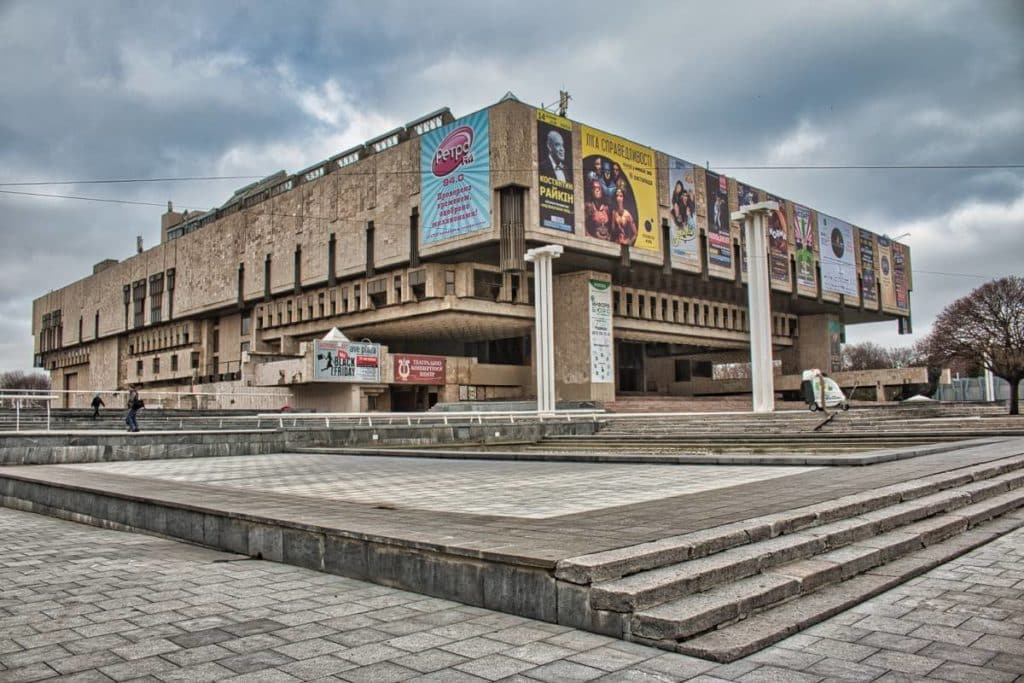
Theater for Opera and Ballet
Construction of the Kharkiv Opera House began as early as 1970. It took 21 years until it was opened as the last building in Soviet Kharkiv. It is one of the few examples of postmodern architecture in Kharkiv. The building with comparatively few windows looks brute for a fine arts building. But even this building in the style of Brutalism has its fans. And the performances in the large hall of the building for up to 1500 people are also an experience.

Pioneer swimming pool
The Pioneer Swimming Hall is located near the Slovo House. I especially like the shape of the roof: it looks like a wave. Address: Dynamivska 5A

Hotel Mir
The Hotel Mir (Peace) is a typical hotel building from the later years of the Soviet Union. Inside, the hotel has been properly renovated, but from the outside it still exudes the brittle charm of the Soviet Union. You can take the elevator to the top floor, where there used to be a restaurant. During my visit, however, I found only cardboard boxes and old potted plants instead of a grand view. Address: Otakara Yarosha 20
Metro Kharkiv
The Kharkiv Metro was not built starting in the late the 1960s and is somewhat more sober than in other cities of the former Soviet Union. It was built when Stalin’s pomp no longer ruled, but sober functionality was in demand. Nevertheless, the trains rattle just as loudly as in Moscow and Kyiv, and some reminders of the Soviet Union can be found here as well. The stations of the red line (Cholodnohirsko-Sawodska line) and blue line (Saltiwska) are particularly beautiful. My two absolute favorites are the Architekta Beketova and Sportivna stations. Beketova is simply the most beautifully designed, while Sportivna station is the archetype of of metro stations without columns. So you can see the Ukrainian flag painted on the wall much better from the stairs.
Soviet Kharkiv for tourists
Of course, I describe mainly the buildings for you to see. But of course there are also some recreational facilities from the Soviet era, which still exist today. And I advise you not to miss them.

Kharkiv Cable Car
And yet another Kharkiv attraction begins in Gorky Park – or ends here, depending on your point of view – the Kharkiv cable car. The British Guardian even named it one of the ten best cable cars in the world. Even though I personally wouldn’t go quite that far now, the cable car is definitely a nice experience. The small gondolas are suitable for two people and therefore especially good for couples. The ride takes about 20 minutes, but you cover a distance of about 1.5 kilometers. So it’s like walking, except that you float above the city and can enjoy the view of Kharkiv.
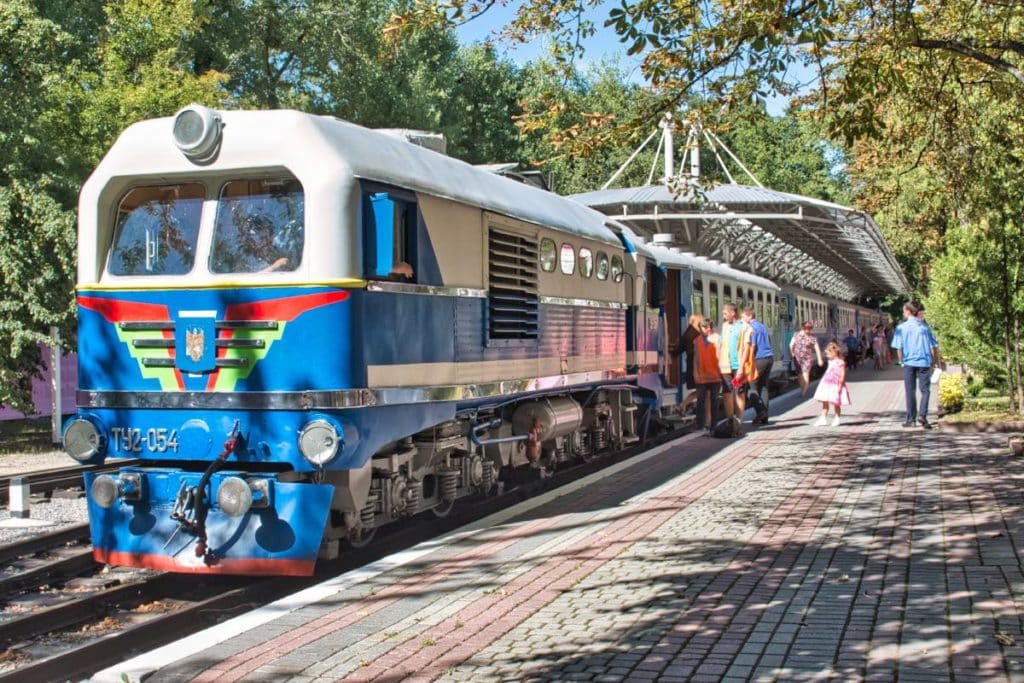
Pioneer Railway
Kharkiv Pioneer Railway was opened back in 1940 and was the thirteenth railroad of its kind in the USSR. Although today the pioneer railroad is simply called a children’s railroad, it is still operated by children of pioneer age. They perform all the same tasks as on the real railroad, with the sole exception of driving. The engineer is the only adult employee on board. The children’s railroads usually run from May to October.
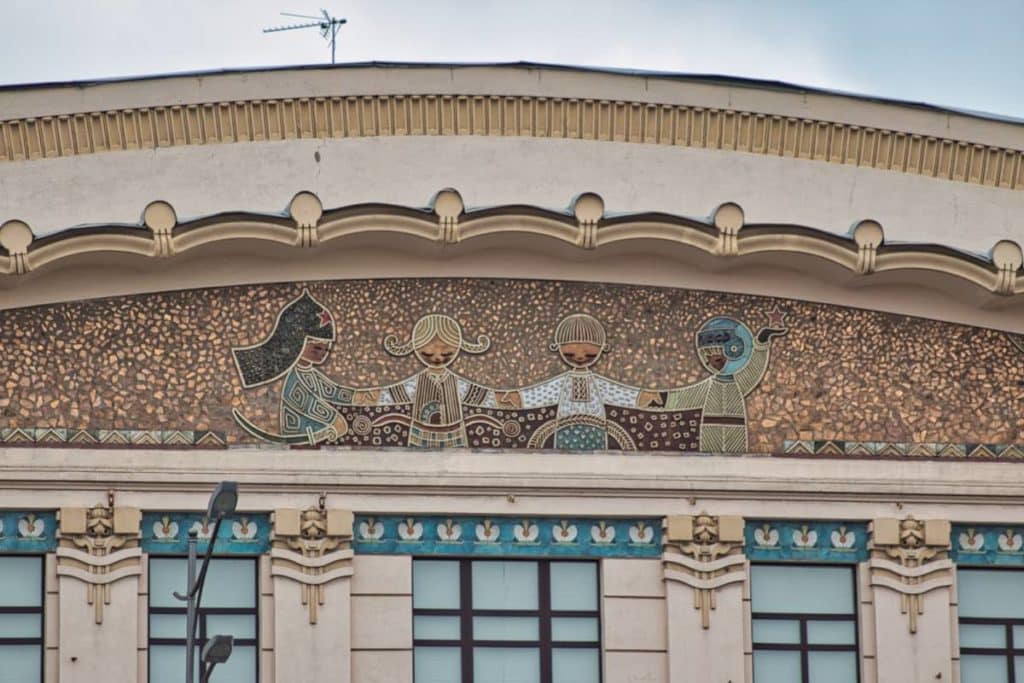
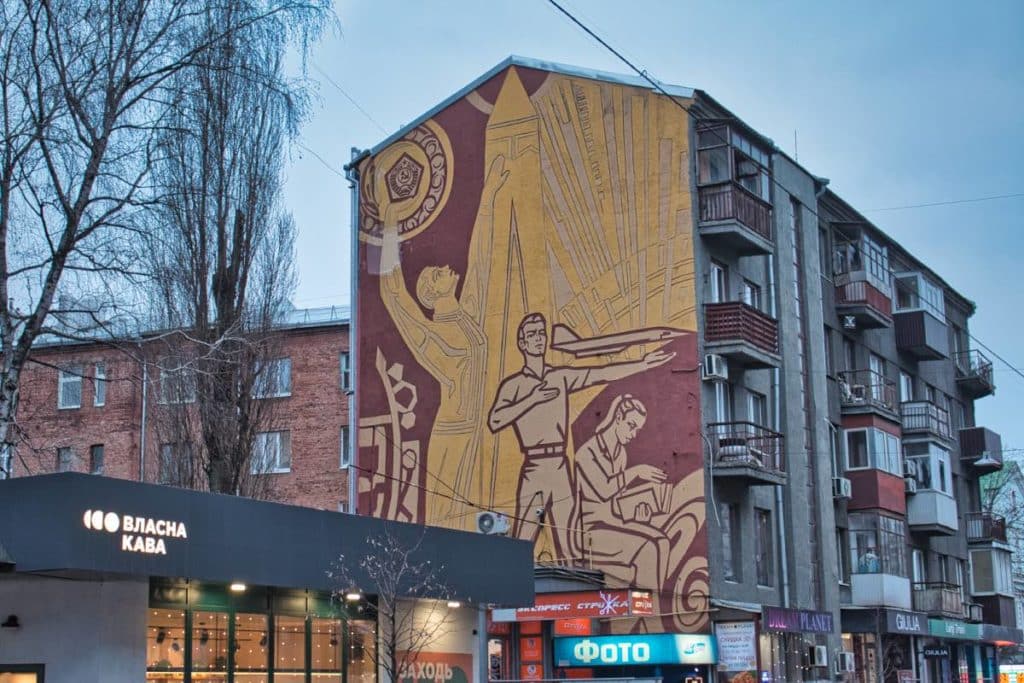

Soviet mosaics and murals in Kharkiv
You can find them everywhere in Soviet cities: propaganda mosaics. My favorite mosaic in Kharkiv is the one at the Puppet Theater on Constitution Square (Maidan Konstituzii). A list with Google Maps to the places of the most beautiful mosaics is available from Soviet Mosaics in Ukraine.
Soviet Memorials
One of the most important pillars of Soviet power is propaganda. It also determines the public space of Soviet cities. Therefore, even in Kharkiv today there are dozens of monuments and memorials commemorating events and people important to the Soviets. Even though the Lenin monuments have disappeared, many other memorials have been preserved. Some of them were also simply rededicated.
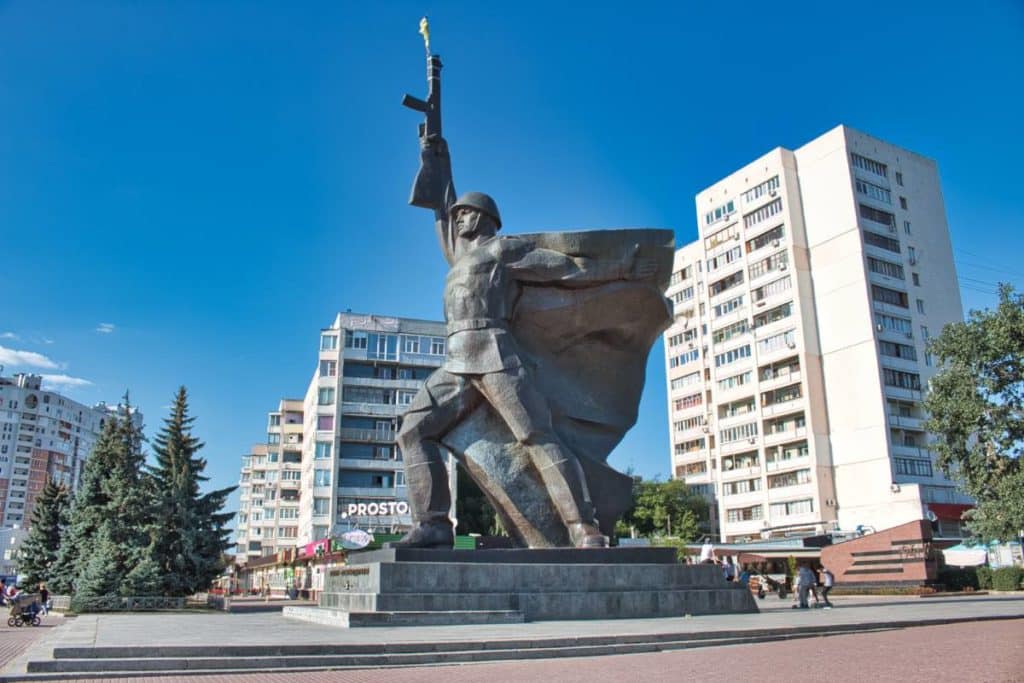
Monument to the soldiers of August 23
The Monument to Liberators of Kharkiv stands at an intersection at the 23ta Serpnia (August 23rd) metro station, named in honor of the day Kharkiv was liberated from German occupation in 1943. The monument was inaugurated in 1981 and includes a statue of a soldier raising a machine gun, as well as emblems on the wall depicting Soviet medals in World War II. The monument is also called Pavlusha by Kharkiv residents and is a popular meeting place.



Monument Complex Slava
The monument complex Slava (Honor) was opened in 1977 and commemorates thousands of war victims who were murdered here by the Nazis. Central statue is the effigy of the Mother of the Fatherland (in Russian Rodina Mat, the Mother of the Motherland), which commemorates the struggle of the Soviet Union against Nazi Germany. Upon entering the complex, there are loudspeakers playing monumental hymns. On the monument you will find the inscription:
“Heroes never die. They become immortal and remain forever in our memory, in our achievements, in the great deeds of the following generations. Descendants owe them their lives.”
In addition to the prisoners of war and civilians who were murdered here, it also commemorates the more than 186,000 Red Army soldiers who fell in the battle for Kharkiv.
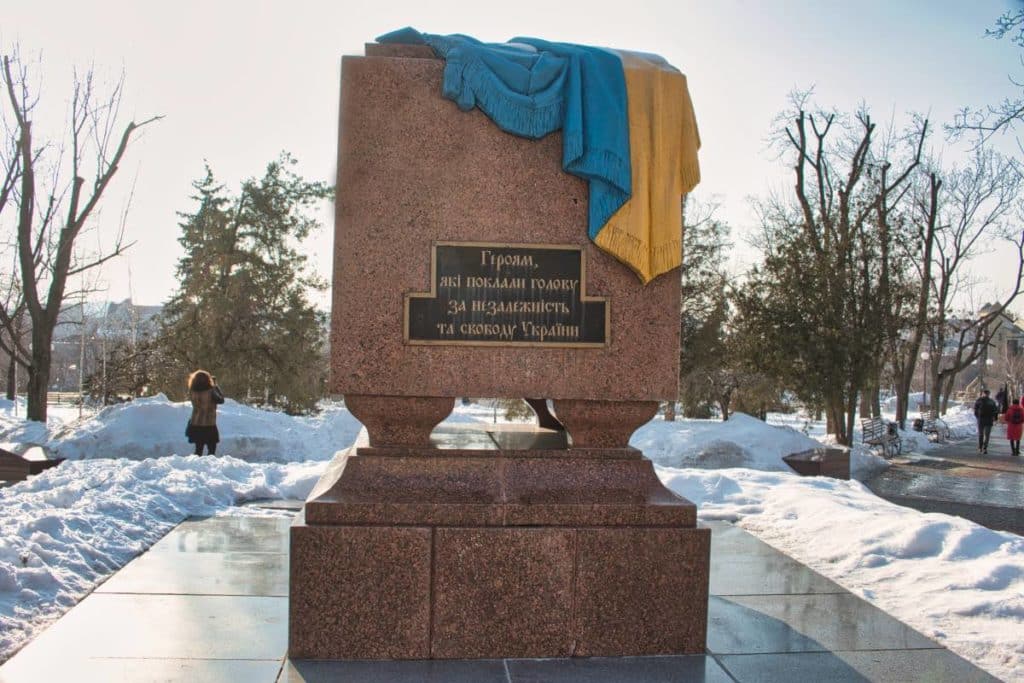
Monument to the fighters of the October Revolution
It is one of the oldest monuments of Soviet Kharkiv – the Monument to the Fighters of the October Revolution. It was consecrated in 1957 on the 40th anniversary of the Okotber Revolution. A year after the inauguration, an eternal flame was added, which was still burning until a few years ago. In 2014 the monument was rededicated and now commemorates the fighters for the independence of Ukraine. The former red flag, which was set in stone with the monument, is now blue and yellow. The new painting and rededication saved the monument from demolition in the course of decommunization. However, the flame has since gone out. Kharkiv people joke about it, saying that gas has become too expensive since the War in Ukraine.


